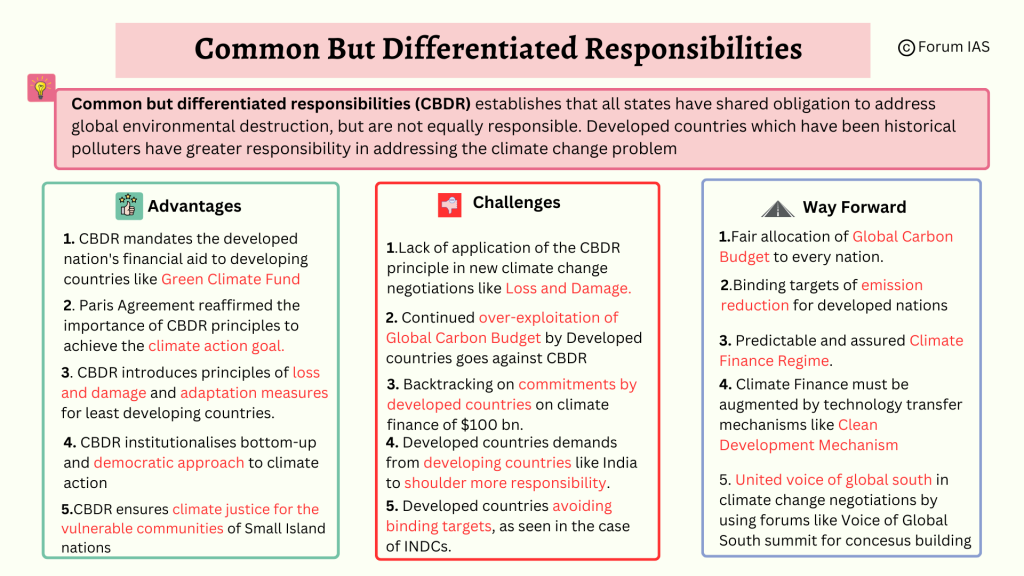Common but differentiated responsibilities (CBDR) principle is back in focus, as the members of United Nations Framework Convention on Climate Change (UNFCCC) assemble for the Conference of Parties (COP 28) meeting in Dubai, UAE. The principle of CBDR was first introduced in the 1992 UNFCCC in Rio De Jenario. The CBDR concept has evolved into CBDR-RC with the addition of Respective Capacities term to it, in the Paris Accord. CBDR-RC principle, has since then been a key element in international environmental agreements involving climate change.
What is the Common but differentiated responsibilities (CBDR) principle?
Common but differentiated responsibilities respective capacities- The concept of CBDR-RC has evolved from the notion of the ‘common heritage of mankind’. The principle recognizes historical differences in the contributions of developed and developing States to the creation of global environmental problems like climate change, global warming. At the same time, the principle also recognizes the differences in the economic and technical capacities of developed and developing countries to tackle these problems.
Key Elements of CBDR-RC explained in detail
| Common Responsibilities | All countries share a common responsibility to address global challenges, such as climate change. This implies a recognition that collective action is necessary to address issues that transcend national borders. |
| Differentiated Responsibilities | Developed countries, which historically have contributed more to environmental issues, have used up the major share of global carbon budget. As such, they are expected to take on more significant commitments and actions compared to developing countries. |
| Respective Capacities | The principle considers the varying capacities of countries to deal with environmental challenges. Developing countries may require support, both in terms of financial assistance and technology transfer, to effectively participate in global efforts to address environmental issues. |

What is the advantage of Common But Differentiated responsibilities (CBDR) principle?
1. Economic benefits to developing countries- CBDR-RC mandates the developed nations to offer technological and financial aid to developing countries in addressing climate challenges. Simultaneously, it alleviates developing countries from the expenses associated with adhering to stringent carbon reduction regulations, indirectly contributing to their economic development and narrowing the gap with developed nations. For Ex- Green Climate Fund, Adaptation Fund etc.
2. Achievement of Climate action goals- The Paris Agreement reaffirmed the importance of CBDR-RC principles to achieve the climate action goal of limiting the rise in global temperature to below 2 degree celsius.
3. Introduction of principle of Equity- CBDR-RC prioritizes equity over equality, ensuring that no country or group is disadvantaged. Instead, it seeks a balanced approach that benefits everyone involved. For Ex- CBDR-RC introduces principles of loss and damage and adaptation measures for developing countries.
4. Bottom-up and Democratic Approach- According to the principle of CBDR-RC, nations have been mandated to formulate Intended Nationally Determined Contributions (INDCs) at the central, state, and grassroots levels. This process involves multiple stakeholders and is fundamentally democratic in its approach and emphasizing a bottom-up methodology. For Ex- Tribals and PVTGs, opinions are taken to draft the action plan for INDCs.
5. Ensures Climate Justice- CBDR-RC ensures climate justice for the vulnerable communities of Small Island nations and least developing countries, who have paid the price without even polluting the environment.
What are the challenges in the application of Common But Differentiated Responsibilities Principles?
1. Application in new climate change negotiations- The present day international climate regime is facing a major challenge in the application of the CBDR-RC principle in new climate change negotiations. For ex- The developed countries’ rejection of the references to the CBDR-RC Loss and Damage fund’s draft.
| Read More- Loss and Damage Fund |
2. Continued over-exploitation of Global Carbon Budget- The developed countries, which have already used 4/5th of global carbon budget, continue their overexploitation of the remaining budget. This reduces the share of developing nations in the carbon budget and goes against CBDR-RC principles.
| Global Carbon Budget- It refers to the maximum cumulative global anthropogenic CO2 emissions from the pre-industrial era to when such emissions reach net-zero. The remaining carbon budget indicates how much CO2 could still be emitted, from a specified time after the pre-industrial period, while keeping temperature rise to the specified limit. |
3. Backtracking on Commitments- Developed countries have been violating the CBDR-RC principles by backtracking on their net-zero targets, climate finance pledges, climate related actions. For Ex- Reopening coal plants across Europe after the Russia-Ukraine war created an energy crisis, failure of the developed countries to provide US $100 billion dollars a year (agreed at COP-15), overstretched net-zero reduction targets (US must achieve net-zero by 2025 instead of 2050 to achieve Paris goals).
4. Attempt at Dilution- The developed countries are attempting to reduce their responsibilities by demanding developing countries like India to shoulder the responsibility of emission reduction. The per capita CO2-FFI (fossil fuel and industry) emissions of South Asia is just 1.7 tonnes CO2-equivalent per capita, which is significantly lower than the world average of 6.6 tonnes CO2-eq. per capita.
5. Avoidance of Binding Targets- Developed countries by avoiding binding targets in the new negotiations have reneged on their responsibility owing to historical contributions. For ex- The Nationally Determined Contributions (NDCs) under the Paris Agreement are voluntary in nature & non legally binding, unlike the Kyoto protocol targets.
Conclusion and Way Forward
1. Fair allocation of global Carbon Budget- The developing and underdeveloped countries must be provided a fair share in the global carbon budget. This will ensure equity as per the CBDR-RC principles.
2. Binding targets of emission reduction- Developed countries, recognizing their historical responsibility, must take binding targets in reducing their emissions. Developed countries must bring forward their net-zero target dates.
3. United Voice of Global South in Climate Change Negotiations- A United voice of global south in climate change negotiations must be built by using forums like Voice of Global South summit for consensus building
4. Predictable and assured Climate Finance- There must be binding targets on developed countries to provide funding to vulnerable countries to ensure adequate compensation for them. For ex- Institution of Loss and Damage Fund (L&D Fund).
5. Technology transfer- Climate Finance must be augmented by technology transfer to the developing nations to help accelerate their transition to low-carbon economies. For ex- Mechanisms like the Clean Development Mechanism.
Every stakeholder- Developed, developing and least developed countries-must realize that the CBDR-RC is still a potent tool to achieve collective viable climate change solutions. COP-28 must be driven by the CBDR-RC principles.
| Read More- The Hindu UPSC Syllabus- GS III, Conservation, Environmental Pollution and Degradation |
Discover more from Free UPSC IAS Preparation Syllabus and Materials For Aspirants
Subscribe to get the latest posts sent to your email.






